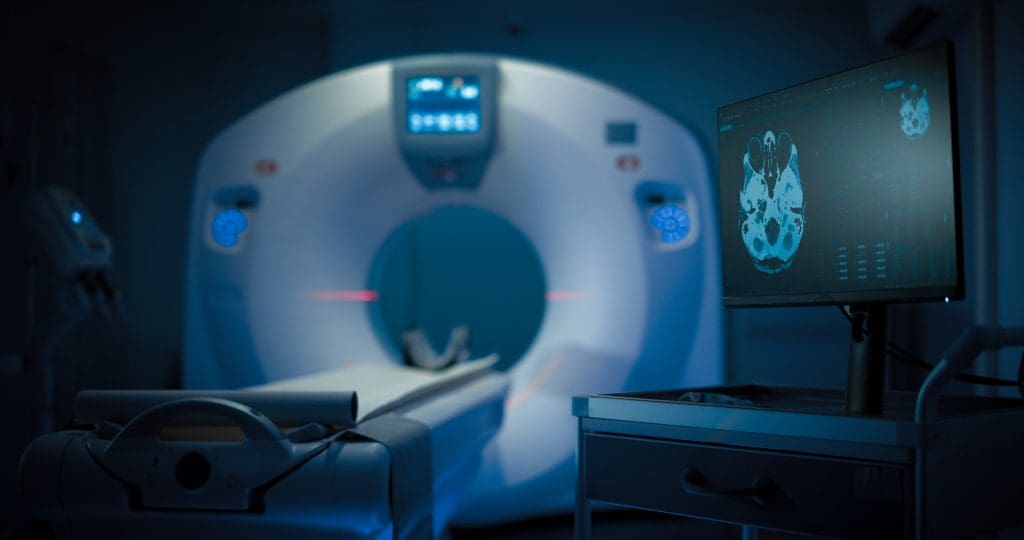Last Updated on November 26, 2025 by Bilal Hasdemir
Every year, over 30 million MRI and PET scans are done in the United States. MRI exams use magnetic fields and radio waves to create detailed images of inside structures. On the other hand, PET scans use a radioactive tracer to show how an organ works in real time.
Both tools are key in medical imaging, but they have different roles. Knowing how they work helps us see their differences.
Key Takeaways
- MRI exams provide detailed images of internal structures using magnetic fields and radio waves.
- PET scans show how an organ is functioning in real time using a radioactive tracer.
- Both MRI and PET scans are vital diagnostic tools in medical imaging.
- Understanding the principles of MRI and PET scans helps appreciate their differences.
- The choice between MRI and PET scan depends on the medical condition being diagnosed.
Medical Imaging Overview
Medical imaging is key in today’s healthcare. MRI and PET scans give deep insights into our bodies. These technologies have changed how doctors diagnose and treat diseases.
The Importance of Advanced Diagnostic Imaging
Advanced imaging is vital in medicine. MRI (Magnetic Resonance Imaging) and PET (Positron Emission Tomography) scans are key for diagnosing many conditions. This includes cancer and neurological disorders.
These imaging tools show detailed views of our body’s inside. Doctors use this to make accurate diagnoses and plan treatments.
Evolution of Medical Imaging Technologies
Medical imaging has grown a lot over time. It started with X-rays and now we have MRI and PET scans. Each step has made diagnosing better.
The creation of pet/mr imaging is a big step. It combines PET and MRI for a deeper look at our bodies.
| Imaging Technology | Primary Use | Key Benefits |
| MRI | Soft tissue imaging, neurological disorders | High-resolution images, non-invasive |
| PET | Cancer diagnosis, metabolic activity assessment | Functional information, early disease detection |
| PET/MRI | Combined functional and anatomical imaging | Comprehensive diagnosis, improved accuracy |
Medical imaging is always getting better. Research keeps pushing for more accurate diagnoses and better patient care. As these technologies grow, we’ll see even better tools for doctors.
What is an MRI Scan?
An MRI scan is a non-invasive way to see inside the body. It uses strong magnetic fields and radio waves. This method gives detailed images without surgery.
How MRI Technology Works
MRI technology aligns hydrogen atoms in the body with a strong magnetic field. Radio waves disturb these atoms, causing them to send signals. The MRI machine picks up these signals to create detailed images.
This process is non-invasive and safe. It doesn’t use harmful radiation, making it good for many medical needs.
Types of MRI Scans
There are many types of MRI scans for different uses. Here are a few:
- Functional MRI (fMRI): It watches brain activity by seeing blood flow changes.
- Magnetic Resonance Angiography (MRA): It looks at blood vessels to find vascular diseases.
- Magnetic Resonance Spectroscopy (MRS): It shows metabolic changes in body tissues.
Common Uses for MRI Scans
MRI scans check joints, blood vessels, and organs. They help find issues like torn ligaments and cancer. MRI images help doctors make accurate diagnoses and plans.
In cancer, MRI scans are key. They find tumors and see how far cancer has spread. This helps doctors choose the right treatment.
In short, MRI scans are a key tool for looking inside the body. They are safe and detailed, making them great for many medical needs, including cancer.
What is a PET Scan?

A PET scan, or Positron Emission Tomography, is a cutting-edge medical imaging method. It shows how the body’s cells work. It’s great for finding cancer, checking heart health, and spotting brain problems.
How PET Technology Works
PET scan technology uses a PET scanner to find energy from a special dye. This dye goes into the body and lights up where cells are very active, like in tumors. The scanner then makes detailed pictures of what’s happening inside the body.
First, a tiny bit of radioactive dye is injected into the blood. It goes to cells all over the body. Cells that are growing fast, like cancer cells, take up more dye. This makes them show up clearly on the scan.
Radioactive Tracers in PET Imaging
The type of dye used in a PET scan depends on what it’s for. FDG (Fluorodeoxyglucose) is often used for cancer because it shows where cells are using a lot of sugar. Other dyes are used for heart disease or brain issues.
These dyes let PET scans show how the body works, unlike other scans that just show what things look like.
Common Uses for PET Scans
PET scans are used in many ways. Here are some examples:
- Cancer diagnosis and staging
- Monitoring cancer treatment response
- Assessing heart disease
- Diagnosing neurological disorders, such as Alzheimer’s disease
The table below shows how PET scans are used for different conditions:
| Condition | PET Scan Application | Benefits |
| Cancer | Diagnosis, staging, and monitoring treatment response | Provides metabolic information, helping to identify aggressive tumors and assess treatment efficacy |
| Heart Disease | Evaluating myocardial viability and perfusion | Helps in assessing the heart’s metabolic activity and identifying areas of reduced blood flow |
| Neurological Disorders | Diagnosing conditions like Alzheimer’s disease | Offers insights into brain metabolism, aiding in the diagnosis of neurodegenerative diseases |
PET scans are less likely to cause claustrophobia than MRI scans because they’re open systems. But, some people might feel uncomfortable because they have to stay very quiet and not move during the scan.
In summary, PET scans are a key tool in medicine. They give deep insights into how the body works. Knowing how they work and what they’re used for helps doctors make better choices for their patients.
The Difference Between MRI and PET Scan
MRI and PET scans are two different tools in medical imaging. They use different technologies to show different things. MRI scans are great for looking at the body’s structure. PET scans show how the body’s cells are working.
Fundamental Technology Differences
MRI scans use strong magnetic fields and radio waves. They create detailed pictures of the body’s inside. PET scans use tiny amounts of radioactive tracers. They show how the body’s cells are using energy.
MRI technology is top-notch for detailed body pictures. It’s key for checking the brain, spine, and soft tissues. PET scans, on the other hand, focus on how the body’s cells are working. This is super helpful for finding cancer.
What Each Scan Reveals
MRI scans are great at showing the body’s structure. They help find injuries, infections, and tumors. PET scans show how active the body’s cells are. They’re super at finding cancer because cancer cells use a lot of energy.
“The combination of MRI’s anatomical detail and PET’s functional information can be incredibly powerful in diagnosing and managing complex medical conditions.”
Comparative Strengths and Limitations
MRI scans are top for soft tissue details but not so good for how the body works. PET scans are great at showing how the body’s cells are working but not as good at showing details. MRI scans can’t show the body’s metabolic activity like PET scans do.
- MRI strengths: Detailed anatomical images, excellent soft tissue contrast.
- MRI limitations: Less effective for functional imaging.
- PET strengths: Provides functional information, useful for assessing metabolic activity.
- PET limitations: Lower anatomical resolution, involves radiation.
Knowing the difference between MRI and PET scans is key. MRI gives detailed pictures of the body. PET scans show how the body’s cells are working. Together, they help doctors make better diagnoses.
Clinical Applications: When to Use MRI vs PET
Choosing between MRI and PET scans depends on the question being asked and the needed information. Each has its own strengths for different diagnostic needs.
Conditions Best Diagnosed with MRI
MRI scans are great for soft tissue issues like ligament and tendon injuries, some neurological problems, and certain cancers. They offer detailed images of these areas.
MRI is often preferred for looking at structural problems. It’s key for diagnosing issues like multiple sclerosis, herniated discs, and torn ligaments. Its clear images of soft tissues without radiation are a big plus.
Conditions Best Diagnosed with PET
PET scans are best for checking metabolic activity in the body. They’re great for finding and tracking cancer, as metabolic changes often show up before structural ones.
PET scans are commonly used to spot cancer, track its growth, and check treatment success. They also help diagnose neurological issues like Alzheimer’s by showing where metabolism is low.
When Doctors Recommend Both Scans
Doctors might suggest both MRI and PET scans for a full view of a patient’s health. For cancer, MRI shows the tumor’s shape, while PET scans reveal its metabolic activity.
Using both scans together helps in treatment planning, like surgery or radiation. This is true for complex cases where one scan isn’t enough.
MRI vs PET Scan for Cancer Detection
It’s important to know the difference between MRI and PET scans for cancer. Both are key in finding and treating cancer. They serve different needs and offer unique benefits.
Detecting Cancer with MRI
MRI scans show detailed images of the body’s inside. They are great for finding tumors in soft tissues. This includes the brain, spine, and organs like the liver and kidneys.
MRI gives doctors clear images of tumors. This helps them plan treatments or surgeries. It’s also good for finding cancers in hard-to-image areas.
Detecting Cancer with PET Scans

PET scans look at how cells in the body work. They spot the changes in cancer cells. These changes are often more noticeable than in normal cells.
PET scans use a radioactive tracer to find cancer. They can spot cancer early, see how far it has spread, and check how well treatments work.
Effectiveness for Different Cancer Types
Choosing between MRI and PET scans depends on the cancer type and where it is. MRI is best for brain and spinal cord tumors. PET scans are good for cancers like lymphoma and melanoma.
Sometimes, doctors use both MRI and PET scans together. This gives a clearer picture of the cancer. It helps in planning better treatments.
In summary, MRI and PET scans are both important for cancer detection and treatment. Knowing their strengths and weaknesses helps choose the right scan for each cancer type.
Patient Experience and Considerations
People’s experiences with MRI and PET scans differ a lot. Some face challenges like claustrophobia, getting ready, and safety worries. Knowing about these helps make the scanning process smoother.
Claustrophobia and Comfort Issues
One big worry for MRI scan patients is claustrophobia. This is because the MRI machine is closed in. Open MRI machines are there for those who feel trapped. PET scans, on the other hand, deal with the injection of radioactive tracers and staying very quiet during the scan.
To help with claustrophobia and comfort, there are a few things you can do:
- Talk to your healthcare provider about your worries before the scan.
- Try relaxation methods like deep breathing or meditation.
- Have someone you know with you during the scan.
- Ask about sedation if your claustrophobia is very bad.
Preparation Requirements
Getting ready for MRI and PET scans is different. For MRI scans, you might need to take off metal items like jewelry and some clothes. For PET scans, you might need to not eat for a while before and avoid hard activities.
It’s very important to follow the exact instructions from your healthcare provider or the imaging center. This makes sure the scan is done safely and works well.
Safety Concerns and Contraindications
There are safety worries for MRI scans, like metal implants, pacemakers, and other medical devices. For PET scans, the main worry is the radioactive tracers. These are usually safe but need to be handled carefully.
Some important safety points to remember are:
| Scan Type | Safety Concern | Precaution |
| MRI | Metal Implants | Screening before scan |
| PET | Radioactive Tracers | Careful dosing and handling |
By knowing these safety tips, patients can get ready better for their scans. This helps reduce risks and makes the diagnostic process work well.
Combined PET/MRI Technology
Healthcare providers now have a new tool to understand patient conditions better. They use PET and MRI together in one scan. This mix gives a clearer and more accurate diagnosis.
How Hybrid Imaging Works
PET/MRI combines PET’s functional info with MRI’s detailed images. It uses special hardware and software to get both types of data at once. This gives a full view of the body’s inside and how it works.
Key components of PET/MRI hybrid imaging include:
- Advanced detectors that can accurately capture PET data
- Sophisticated MRI sequences that provide high-resolution anatomical images
- Complex algorithms that integrate PET and MRI data into a single, coherent image
Benefits of Simultaneous Scanning
Scanning with PET/MRI at the same time has many benefits. It saves time because patients don’t have to go through two scans. This makes them more comfortable and reduces errors from moving between scans.
“The integration of PET and MRI in a single modality has the power to change diagnostic imaging. It gives both functional and anatomical info in one scan.”
Current Applications of PET/MRI
PET/MRI is used in many areas like oncology, neurology, and cardiology. In oncology, it helps find and track cancer better. In neurology, it helps study brain diseases.
PET/MRI improves diagnosis, makes patients more comfortable, and helps plan treatments better. As it gets better, we’ll see new uses for it in the future.
Conclusion
It’s important to know how MRI and PET scans work. They help doctors a lot in diagnosing and treating patients. Each scan gives different views of the body’s inner workings.
Choosing between MRI and PET scan depends on what the doctor needs. MRI shows detailed body structures. PET scans focus on how cells work.
So, what’s the difference between a PET scan and an MRI? It’s mainly about their technology and what they show. PET scans look at cell activity, while MRI shows body parts.
In the end, MRI and PET scans are both essential in today’s medicine. Knowing their differences helps doctors make better diagnoses and treatments. This way, patients get the best care possible.
FAQ
What is the main difference between an MRI and a PET scan?
MRI uses a strong magnetic field and radio waves to show body details. PET scans use a radioactive tracer to see how the body works.
Which is better for detecting cancer, MRI or PET scan?
MRI is great for seeing body structures and finding tumors. PET scans are better at showing how tissues work, helping find cancer and check treatment.
Can I undergo an MRI scan if I have claustrophobia?
Yes, but it might need special care. Some MRI machines are open or have a wider space. Sedation or relaxation can also help with anxiety.
What is a PET/MRI scan, and how does it differ from a standalone PET or MRI?
A PET/MRI scan combines PET’s function with MRI’s anatomy in one scan. It gives a detailed look at body structures and how they work.
Are there any safety concerns associated with MRI or PET scans?
MRI is usually safe, but some implants or pacemakers might be a problem. PET scans use a small amount of radiation, but are safe when needed.
How do I prepare for a PET scan or MRI?
Preparing varies by scan and doctor’s instructions. You might need to fast or avoid certain foods and meds. Always follow the instructions carefully.
Can I get a full-body PET scan?
Yes, full-body PET scans are available. Some machines are designed for those who are claustrophobic. Availability depends on the imaging center.
What’s the difference between a PET scan and an MRI in terms of detecting cancer metastasis?
PET scans are better at finding cancer spread because they show metabolic changes. MRI can also find metastasis, but PET scans might be more accurate in some cases.
Are there any new advancements in MRI or PET scan technology?
Yes, new tech is coming for both MRI and PET scans. Hybrid imaging like PET/MRI is being developed. These aim to improve accuracy, reduce time, and make scans more comfortable.






